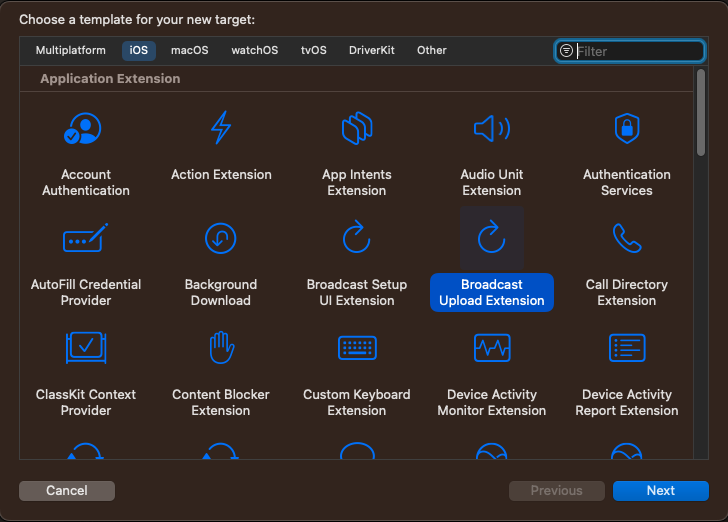Screen Sharing
Introduction
During the duration of a call, participants may want to share either a portion of their screen, application or their entire screen to other users on the call. Stream Video makes it easy to support screensharing to other users natively on both Android and iOS devices.
In this guide, we will look at the steps required to configure screensharing on both platforms. If you are interested in screensharing for just one platform, you can skip to the Android or iOS section using this link.
iOS
Starting with iOS, there are two main options for screensharing from an iOS device. These are:
- in-app screensharing - In this mode, the app's screen is only shared while the app is active or in the foreground. If the app is not in the foreground, screensharing is paused.
- broadcasting - Using broadcasting mode allows the app to share the contents of the screen even when the application goes into the background.
Both of these options use Apple's framework ReplayKit (via flutter_webrtc) for broadcasting the user's screen.

Before a user can share their screen, the call must have the screensharing capability configured via the Dashboard.
In-app sharing
In-app screensharing only shares the application's screens. While in a call, screensharing can be enabled by calling call.setScreenShareEnabled(enabled: true) method.
void startSharing() {
// Checks to ensure the user can share their screen.
final canShare = call.hasPermission(CallPermission.screenshare);
if (canShare) {
// Set screensharing to enabled
call.setScreenShareEnabled(enabled: true);
}
}
If you use our UI components you can also add ToggleScreenShareOption as one of StreamCallControls option.
When the method is invoked, ReplayKit will ask for the user's consent that their screen will be shared. Only after the permission is granted, the screensharing starts.
Broadcasting
In most cases, you would need to share your screen while you are in the background, to be able to open other apps. For this, you need to create a Broadcast Upload Extension.
Toggle screen sharing with broadcast mode
If you want to start screen sharing in broadcast mode on iOS you will need to toggle on using ScreenShareConstraints. Just set the flag to true inside ToggleScreenShareOption or when you use call.setScreenShareEnabled() directly.
const constraints = ScreenShareConstraints(
useiOSBroadcastExtension: true,
);
...
ToggleScreenShareOption(
...
screenShareConstraints: constraints,
),
//or
call.setScreenShareEnabled(enabled: true, constraints: constraints);
Add Broadcast Upload Extension
Now add the extension, without UI, to your project in Xcode:


Make sure the deployment target for both your app and broadcast extension is set to iOS 14 or newer.
After you create the extension, there should be a class called SampleHandler, that implements the RPBroadcastSampleHandler protocol. Remove the protocol conformance and the methods, import our stream_video_screen_sharing, and make the SampleHandler a subclass of our class called BroadcastSampleHandler, that internally handles the broadcasting.

If Xcode cannot find the stream_video_screen_sharing module add this code block to your app's Podfile file:
target 'ScreenSharing' do
use_frameworks!
pod 'stream_video_flutter', :path => File.join('.symlinks', 'plugins', 'stream_video_flutter', 'ios')
end
Replace ScreenSharing with your extension name.
Setup app groups
Add your extension to an app group by going to your extension's target in the project. In the Signings & Capabilities tab, click the + button in the top left and add App Groups. If you haven't done so already, add App Groups to your main app as well, ensuring that the App Group identifier is the same for both.
Update Info.plist
Finally, you should add a new entries in the Info.plist files.
In both the app and the broadcast extension, add a key RTCAppGroupIdentifier with a value of the app group id and RTCScreenSharingExtension key with a value of a bundle id of your extension.
With that, the setup for the broadcast upload extension is done.
Android
The Stream Video SDK has support for screen sharing from an Android device. The SDK is using the Android Media Projection API for the capture. To initiate screen sharing, user consent is mandatory.
When using the ToggleScreenShareOption within the stream_video_flutter package, permission handling is seamlessly integrated. However, if you opt to initiate screen sharing via the setScreenShareEnabled() method on the Call object, you will be responsible for securing the necessary permissions and initiating a foreground service. The foreground service is essential for displaying a notification to the user while screen sharing is active.
Below is an example snippet that demonstrates how to use our built in StreamBackgroundService class to manage these requirements:
if (/*sharing enabled*/) {
await StreamBackgroundService().startScreenSharingNotificationService(call);
} else {
await StreamBackgroundService().stopScreenSharingNotificationService();
}
You can customize the notification content and behavior by initiating StreamBackgroundService:
StreamBackgroundService.init(
StreamVideo.instance,
onNotificationClick: (call) async {
//TODO navigate to call
},
onButtonClick: (call, type, serviceType) async {
switch (serviceType) {
case ServiceType.call:
call.end();
case ServiceType.screenSharing:
StreamVideoFlutterBackground.stopService(ServiceType.screenSharing);
call.setScreenShareEnabled(enabled: false);
}
},
);
In case of using flutter_background you will also need to add a media projection service declaration in AndroidManifest.xml.
<service android:name="de.julianassmann.flutter_background.IsolateHolderService"
android:foregroundServiceType="mediaProjection"
android:enabled="true"
android:exported="false"/>